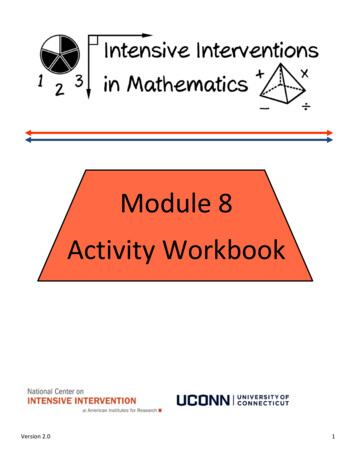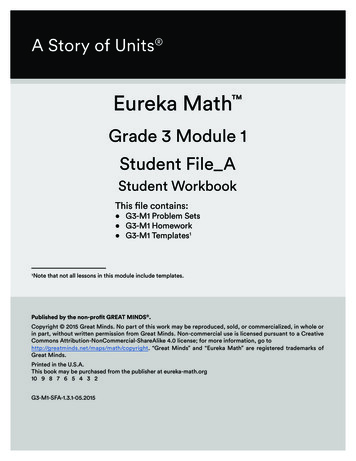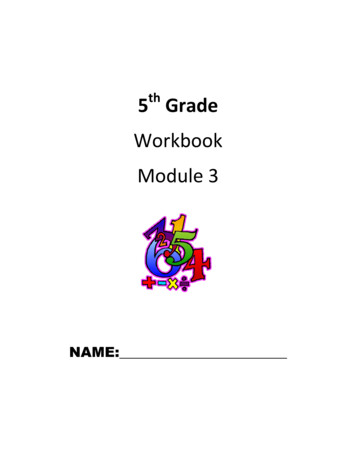
Transcription
Module 8Activity WorkbookVersion 2.01
ContentsModule 8 ChecklistActivity #1 – Compare Fidelity Checklist to Accompanying LessonActivity #2 – Choosing Qualitative ComponentsActivity #3 – Create and Use Fidelity ChecklistDiscussion Board – Rate Fidelity of a TutorActivity #4 – Extend Adaptation Within DBIActivity #5 – Analyze and Improve a Previous LessonDiscussion Board – Current Decision-Making within DBIActivity #6 – Create DBI Implementation PlanDiscussion Board – Share Excitement and Concerns About DBIClassroom Application: Implement DBIReferencesVersion 2.0Page3491015161718192223242
The purpose of this Activity Workbook is to help organize content for this Module. You will do some Activities on your own to helpyou engage with and think about the content. You will not be required to submit your responses for those activities. There areother activities, however, that you will submit online and apply in your classroom. The activities that you must submit beforecompleting this Module are listed in the “Online” column below.IntroSectionAssignmentTo Be CompletedIn Activity WorkbookPart 1Activity 3Video PresentationAccompanying Lesson Choosing QualitativeComponents Create and Use Fidelity Checklist Discussion Board:Rate Fidelity of a Tutor Watch Module 8 Part 2Video PresentationVideoPart 2Activity 5With Coach Compare Fidelity Checklist toDiscussionActivity 4 Watch Module 8To Be Completed Watch Module 8 Part 1VideoActivity2OnlineIntroduction VideoPresentationVideoActivity 1To Be Completed Extend Adaptation within DBI Analyze and Improve a PreviousLesson Discussion Board:Current Decision Makingwithin DBIDiscussion Write Your Response Respond to 2 Others Watch Module 8 Part 3Part 3VideoActivity 6NextStepsDiscussionVersion 2.0VideoClassroomApplicationVideo Presentation Create DBI Implementation Plan Discussion Board:Share Excitement and ConcernsAbout DBI Write Your Response Respond to 2 Others Watch Module 8 ClosingVideo Presentation Implement DBI3
Module 8 Part 1 Activity #1Look at the fidelity checklist and accompanying lesson.Compare to understand how much detail is provided within the fidelity checklist.Version 2.04
Version 2.05
Module 8 Part 1 Activity #1 (cont.)Version 2.06
Module 8 Part 1 Activity #1 (cont.)Version 2.07
Module 8 Part 1 Activity #1 (cont.)Version 2.08
Module 8 Part 1 Activity #1 (cont.)Version 2.09
Module 8 Part 1 Activity #2Go back and look at the lesson for Activity #1.What qualitative components would you include on a qualitative fidelity checklist?(List at least three.)1.2.3.4.Version 2.010
Module 8 Part 1 Activity #3First, look at the materials for a lesson on counting up.What quantitative and/or qualitative components would you include on a fidelity checklist?Hi, ,Today we are going to practice counting up to help us with adding. This is important, becauseyou don’t always know the answer for an addition problem right away in your head, but youcan still answer problems you don’t know, really quickly!First, I want you to look at this problem. (Point to A.) It says 6 plus 8 is the same as blank. Showme how you would answer this problem.Student responds.Awesome work! Sometimes when you add two numbers together, you know the answer rightaway in your brain, and that’s great! But sometimes, we don’t know the answer right away.Counting up is a neat trick to help you figure out the answer quickly.Display Counting Up Addition poster.This poster shows the three steps to counting up for adding. Let’suse these steps to solve 4 plus 2 is the same as blank. (Point to B.)The first step says, “Put the greater number in your fist and say it.” (Point to Step 1.)Greater means bigger, larger, or more. Which number is more?4.That’s right! Start with the greater number, 4. Put that number in your fist and say, “4.”Tap closed fist on leg and say, “4.”Version 2.011
Module 8 Part 1 Activity #3 (cont.)Look at Step 2. (Point to Step 2.) Step 2 says, “Count up the lesser number on your fingers.”Now, count up 2 more, and use your fingers to keep track of how many you’re adding.Watch me.I put the greater number in my fist, 4 (tap closed fist on leg), 5 (hold up 1 finger), 6 (holdup 2 fingers). I knew I had to add 2 more to 4 (point to“ 2”). I used my fingers to makesure I counted up exactly 2 more (show students the 2 fingers still held up).Now look at Step 3. (Point to Step 3.) Step 3 says, “Your answer is the last number you say.”Watch: I put the greater number in my fist, 4 (tap closed fist on leg), 5 (hold up 1 finger), 6(hold up 2 fingers). What was the last number I said out loud?6.So, what’s the answer to 4 plus 2?6.That’s right! 4 plus 2 is the same as 6. Write 6 in the blank.(Student writes 6.)Just like the number line, be careful! When you count up with your fingers, don’t put afinger up for the number you start with. That number goes in your fist. You have to addmore fingers!Watch me. I’ll practice this problem. (Point to C.) 7 plus 3 is the same as blank. I put thegreater number, 7, in my fist. (Tap closed fist on leg and say, “7.”) Then I count up 3 more.Watch: 8 (hold up 1 finger), 9 (hold up 2 fingers), 10 (hold up 3 fingers). 10 is the last numberI say. That’s the answer. Write 10 in the blank.(Student writes 10.)I use my fingers to keep track of how many I add. So, 7 plus 3 is the same as 10. 10 is morethan 7 and more than 3. Your answer is always more than each of the numbers you addtogether.Before we solve the next problem, I’ll tell you something cool about addition problems. Inaddition problems, you always start with the greater number. It doesn’t matterVersion 2.012
Module 8 Part 1 Activity #3 (cont.)whether the greater number is here (point to 7 of 7 3) or here (point to 3 of 7 3). Youalways start with the greater number. What number do you always start with?The greater number.That’s right! For addition problems, you always start with the greater number.The greater number.That’s right! For addition problems, you always start with the greater number.Now, let’s practice counting up together. Look at this problem. (Point to D.) This problemsays 3 plus 4 is the same as blank. In this problem, the greater number, 4, doesn’t comefirst. You still solve the problem the same way, though.What number do you put in your fist?4.Yes, put the 4 in your fist.(Student taps closed fist on leg and says) 4.How many do you count up?3.So, count up 3 more.5 (student holds up 1 finger), 6 (student holds up 2 fingers), 7 (student holds up 3 fingers).So, what’s 3 plus 4?7.Yes, 7 was the last number you said. 7 is the answer. 3 plus 4 is the same as 7. Writeyour answer in the blank.Version 2.013
Module 8 Part 1 Activity #3 (cont.)(Student writes 7.)Let’s try this problem. (Point to E.) 6 plus 4 is the same as blank. Show me how to countup 6 plus 4.(Student counts up.)Very good. (Count up 6 plus 4.) 6 plus 4 is the same as 10. Write your answer in the blank.(Student writes 10.)Let’s try another problem. (Point to F.) This problem says 5 plus 8 is the same as blank. Thisis an addition problem, so the answer is more than each of the numbers you add together.Try counting up 5 plus 8.(Student counts up.)Great. (Count up 5 plus 8.) 5 plus 8 is the same as 13. Write your answer in the blank.(Student writes 13.)(Point to G.) This problem says 7 plus 6 is the same as blank. Show me how to count up 7plus 6.(Student counts up.)Awesome. (Count up 7 plus 6.) 7 plus 6 is the same as 13. Write 13 in the blank.(Student writes 13.)Let’s try one more problem. (Point to H.) Show me how to count up 8 plus 9.(Student counts up.)Yes! (Count up 8 plus 9.) 8 plus 9 is the same as 17. Great job! Write 17 in the blank.(Student writes 17.)Nice work with addition! You earn a treasure coin!Version 2.014(Lesson adapted from 3rd Grade Pirate Math, Texas Edition)
Your “Counting Up” Fidelity Checklist Module 8 Part 1 Activity #3 (cont.) Version 2.015
Then, watch the video.Rate the tutor against yourchecklist.https://youtu.be/aUEm1rmCWxgVersion 2.016
Module 8 Part 1 DiscussionShare your fidelity checklist from Activity #3 and describe how well the tutor adhered toyour checklist.(This space is for organizing your ideas.)Version 2.017
Module 8 Part 2 Activity #4List three additional ways to adapt the mathematics content with DBI. Describe why eachmight be helpful.1.2.3.Version 2.018
Module 8 Part 2 Activity #5Select a lesson that you taught recently. Fill in the graphic organizer about howyou used explicit instruction.Then, go back and revise your lesson by including one additional component of modeling,guided practice, independent practice, and each of the support practices. In other words,how could you have done it better?ModelingPracticeI DoWe DoYou DoSupporting PracticesVersion 2.019
Module 8 Part 2 DiscussionDescribe how you will make decisions about adaptations within DBI.Will you work on your own or with a team?What resources will you have available?Write an original post on the Discussion Board and respond to two peers.(This space is for organizing your ideas.)Version 2.020
Module 8 Part 3 Activity #6Create your plan for implementation of DBI. Fill in the DBI diagram.Version 2.021
Version 2.022
Version 2.023
Module 8 Part 3 DiscussionShare your excitement and concerns about starting (or continuing) DBI.Write an original post on the Discussion Board and respond to two peers.(This space is for organizing your ideas.)Version 2.024
Module 8Use the activities in this workbook as a platform to demonstrate what you’ve learned aboutDBI and how you are implementing the DBI process in your classroom!Version 2.025
Powell, S. R., & Fuchs, L. S. (2015). Intensive intervention in mathematics. Learning Disabilities Research andPractice, 30, 182–192. https://doi.org/10.1111/ldrp.12087Version 2.026
The purpose of this Activity Workbook is to help organize content for this Module. You will do some Activities on your own to help you engage with and think about the content. You will not be required to submit your responses for those activities. There are other activities, however, that you will submit online and apply in your classroom.











